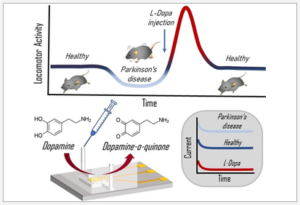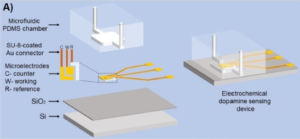 A very thorough characterisation paper was published a few weeks ago in Analytical Chemistry by researchers in Amal Alachkar’s group at UC Irvine, and Nicolas Voelcker‘s and Victor Cadarso‘s groups at Monash University. The collaboration made a microfluidic dopamine sensor that detected dopamine in blood or cerebrospinal fluid (CSF) obtained from mice used to model Parkinson’s disease. Dopamine is a small molecule that acts as a neurotransmitter in the brain and as a hormone with different functions elsewhere in the body including blood vessels, kidneys, the pancreas and the immune system.
A very thorough characterisation paper was published a few weeks ago in Analytical Chemistry by researchers in Amal Alachkar’s group at UC Irvine, and Nicolas Voelcker‘s and Victor Cadarso‘s groups at Monash University. The collaboration made a microfluidic dopamine sensor that detected dopamine in blood or cerebrospinal fluid (CSF) obtained from mice used to model Parkinson’s disease. Dopamine is a small molecule that acts as a neurotransmitter in the brain and as a hormone with different functions elsewhere in the body including blood vessels, kidneys, the pancreas and the immune system.
 The microfluidic devices were fairly simple in structure, with a three-electrode configuration used for the amperometric detection patterned on the oxide layer of a silicon substrate, and a single channel/chamber fluidic structure fabricated in PDMS that was bonded to the silicon baseplate.
The microfluidic devices were fairly simple in structure, with a three-electrode configuration used for the amperometric detection patterned on the oxide layer of a silicon substrate, and a single channel/chamber fluidic structure fabricated in PDMS that was bonded to the silicon baseplate.
Characterisation tests showed robust performance. Good repeatability was seen across ten replicate devices, linear ranges extended through 4 decades and included an LoD at 0.1 nM in both CSF and phosphate buffer. The current plots showing the dynamic range appeared quite steady and smooth at 0.1 nM, and well apart from the baseline, so I wonder if a 3-standard deviation mark would lie well below 0.1 nM? Regardless, this was adequate to easily sense the physiological levels of dopamine in the test mice CSF in the range of 0.1-1 nM. It also showed good selectivity in the presence of interferents. The good analytical performance is likely attributable to the small 2.4 µL chamber, relatively large electrode array (~1 mm²) and narrow (50 µm) separation between the electrodes.
The ability to detect dopamine is of great interest, since abnormal dopamine levels are indicative of neurological conditions such as depression, schizophrenia, attention deficit hyperactivity disorder (ADHD) and Parkinson’s disease. In the case of Parkinson’s disease, an effective sensor can help both with diagnosis and with treatment, as patients are often treated with L-DOPA, a chemical precursor to dopamine, to help reach optimal levels.
